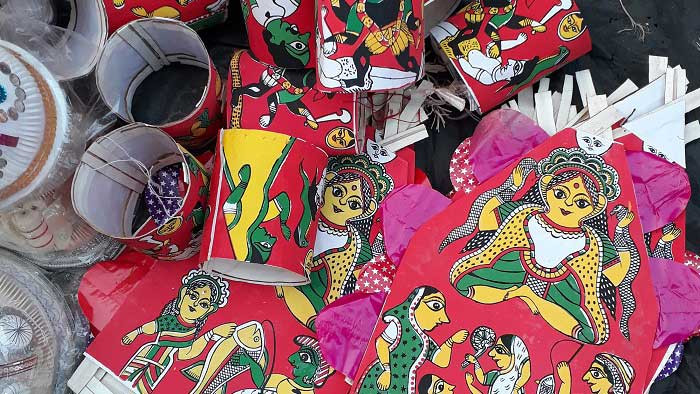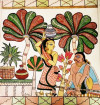Masan painting is a primordial artform that is found to be practiced mainly in northern West Bengal and northern Bangladesh including some parts of Assam, Meghalaya, Bihar, and eastern Nepal. The word Masan is derived from the word “Shashan” which is the Bengali of the Hindu cremation ground. Masan art, also known as Masan chitrakala, is mainly practiced by the Rajbangshi (Rajbonshi) tribe in Bengal and it has high cultural and religious importance in the lives of the Rajbangshi community.
History and Development of Masan Painting
The practice of Masan artform is linked to worship of Masan Devta, the roots of which can be traced back to the spread of the ancient Bon religion of Tibet in North Bengal and North Eastern India. It was a branch of Tantrik Buddhism where the deities were to be worshipped near a crematorium.
In the earlier days, due to the absence of modern technologies and education among tribal people, they used to believe in superstitions and outdated customs like pleasing the God of crematoriums or Masan Devata for keeping everyone healthy. Such beliefs had led to the emergence of Masan Puja which involved masan painting.
The earliest representations of Masan deities were painted on silk cloth which was similar to Tibetian Thangka. Later, the practice of painting the deities on silk cloth was changed into drawing on paper or Shola ( a wild plant).
Themes & Motifs
Masan paintings are colourful paintings made by traditional garland makers known as Malakars. At present, the background on which the art is drawn is made from Shola ( wild plant part) where the painters draw different motifs and structures. Since these paintings are used for religious purposes and rituals, the motifs are mainly of different deities, tribal Gods, and Goddesses of the Rajbangshi tribe. Since the art has Tantrik influence, the deities drawn have bizarre and fearsome appearances.
Raw Materials and Colors Used
The paintings are drawn using handmade brushes and natural colours on the shola. Each colours and motifs have specific significance among the people. Some of them are used to cure diseases, some are painted to celebrate the birth of a baby while specific motifs are drawn for making the topor (headgear for the groom) and sithi mukut (the headgear of the bride) during marriage ceremonies.
Notable Artists
Madhusudan Das is a notable artist who is not only an alumnus of Fine Arts from Visva Bharati University, Shantiniketan but also a crusader working hard to uplift the age-old Masan painting and art form to the modern world. He has done thorough research about Masan painting by spending hours with the Rajbansi people in North Bengal, observing their artwork, and learning the fundamentals of the art.
The Present Scenario of the Art
With the advancement of technology and the spread of education among the Rajbangshi tribal people, this culture is fading away. There are very few people only among them who still practice the artform as the knowledge and techniques were passed onto them for generations and they are willing to keep their indigenous art form alive. Since the paintings are used on various religious and cultural occasions among the Rajbangshi people, the demand for the paintings is still present and they are sold in the markets.
Other than painting, household items or room decorations are now decorated using Masan painting. Eminent artist Madhusudan Das is also putting in a lot of effort by conducting exhibitions and workshops to bring this age-old tribal art to the forefront.
Apart from local Rajbangshi markets, Masan paintings and other items are also available in online websites like ARTSofINDIA.in which has extended its support to the artists for promoting and selling their crafts to the bigger world.
Picture Source: Daily Observer



